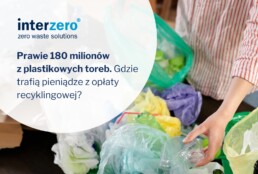
Almost 180 million from plastic bags. Where will the money from the recycling levy go?
Nearly PLN 180 million - that is how much revenue was generated from the recycling fee for 2024. Since 2018, every plastic shopping bag (except for the so-called rip-offs) has been subject to an additional fee, the aim of which is not only to contribute to the state budget, but, above all, to reduce the use of disposables. Does it work? We check.
Nearly £180 million in revenue from the recycling fee
The Ministry of Climate and Environment has announced the amount of revenue from the recycling levy for 2024, amounting to nearly £178.7 million, 6 million more than in 2023. The Ministry of Climate and Environment estimates that the total revenue from the recycling levy for 2025 should remain at the same level as for 2024.
As a reminder, the recycling fee covers almost all plastic shopping bags with the exception of so-called rip-offs - very light bags of less than 15 micrometres thickness used for hygiene purposes. As of 2018, the rate of the recycling fee is invariably PLN 0.20 + VAT for each bag issued to a customer.
Find out more about the recycling levy for commercials >>
What is the recycling levy used for?
The mandatory recycling fee was introduced on 1 January 2018. Initially, it only applied to plastic bags up to 50 microns thick. As of 1 September 2019, the legislation was sealed and the recycling fee was extended to other bags with a material thickness of 50 microns and above. Currently, the recycling fee is settled quarterly and paid into an account held by the provincial marshal.
Revenues from the recycling levy in 99% constitute revenue for the state budget and in 1% for the budget of the provincial government. This 1% of the proceeds is used to cover the costs of enforcement of the recycling fee and the additional recycling fee and the administrative operation of the system for collecting these fees. The remaining amount is transferred by the provincial marshal to the state budget.
Recycling levy as a way to shape consumer behaviour
According to the climate and environment ministry, the introduction of a recycling levy encouraged consumers to use alternative bags. Just before the mandatory levy was implemented, the ministry estimated the average annual consumption of all types of plastic bags at 300 bags per capita. Based on data on the amount of the recycling levy paid, the ministry calculated that this consumption had fallen to, respectively:
- 9 units per person per year in 2018,
- 3.7 units per person per year in 2019,
- 5.2 units per person per year in 2020,
- 5.3 units per person per year in 2021,
- 5.5 units per person per year in 2022,
- 6.1 units per person per year in 2023.
However, it is worth remembering that these statistics relate only to bags with a material thickness of more than 15 micrometres. The scale of use of all plastic bags is difficult to estimate. According to IOŚ-PIB data, in the whole of 2022, Polish retailers issued 865,280,860 plastic bags to their customers, of which 3.9% were very light bags (so-called rip-offs), 24% light bags with a material thickness of 15 to 49 micrometres, and 72.1% other bags with a material thickness of 50 micrometres or more[i].
[i] IOŚ-PIB, Packaging and packaging waste management in Poland in 2022., https://ios.edu.pl/wp-content/uploads/2024/09/gospodarka-opakowaniami-i-odpadami-opakowaniowymi-w-polsce-w-2022-r-2.pdf
Still other data can be found in the latest review of environmental policy implementation:
Poland has managed to achieve a noticeable reduction in plastic shopping bag consumption per capita - from 23 in 2019 to 6.6 in 2022, the second best rate in the EU.
First data on the charge for disposable cups and takeaway food packaging (SUP)
2024 was the first year in which businesses charged for single-use plastic food and beverage packaging. SUP charge rates were set at:
- £0.20 for drinks cups,
- £0.25 for food packaging.
The Ministry of Climate and Environment informed via PAP that approximately PLN 156.6 million was received by the National Fund for Environmental Protection and Water Management from charges for disposable cups and food packaging in 2025. Almost ¼ of the total sum (PLN 40 million) came from entrepreneurs from the Mazowieckie Voivodeship.
The ministry is withholding estimates for the SUP levy revenue in future years for the time being. It argues that this is a new levy and no conclusions can be drawn on the basis of the data currently available.
Do fees encourage people to be eco? The answer can be found in Interzero report In the traps of disposability >>